Book contents
- Frontmatter
- Contents
- List of Contributors
- Preface
- Acknowledgements
- Part I Operations within Organisations – Building Blocks
- Part II Approaches to Understanding OM
- Part III Moving Forward with OM – Creating Competitive Advantage
- Part IV Challenges and Opportunities in Operations
- Part V Case Studies
- 1 Innovation in the Biotechnology Sector: The Case of IDT Australia
- 2 New Zealand King Salmon: Value-Chain Innovation
- 3 Pilila Clothing Company Goes Lean
- 4 From Singapore to the World: Port Management in Singapore
- 5 Striving for Operations Excellence within Queensland Rail Supply Division
- 6 Should I Stay or Should I Go? Shiraishi Garments Company
- 7 Towards a Green Supply Chain: Toyota Australia
- 8 Process Analyses and Improvement at Bartter Enterprises
- 9 Operations Challenges at Firth Industries Limited, Wellington Division
- 10 Ford Motor Company: Moving Forward in Australia
- 11 Technology Transfer at Hero Honda
- 12 Why Is the Patient Resident Time so Long?: The Case of St Martin's and Charity Private Hospital
- Index
12 - Why Is the Patient Resident Time so Long?: The Case of St Martin's and Charity Private Hospital
Published online by Cambridge University Press: 05 June 2012
- Frontmatter
- Contents
- List of Contributors
- Preface
- Acknowledgements
- Part I Operations within Organisations – Building Blocks
- Part II Approaches to Understanding OM
- Part III Moving Forward with OM – Creating Competitive Advantage
- Part IV Challenges and Opportunities in Operations
- Part V Case Studies
- 1 Innovation in the Biotechnology Sector: The Case of IDT Australia
- 2 New Zealand King Salmon: Value-Chain Innovation
- 3 Pilila Clothing Company Goes Lean
- 4 From Singapore to the World: Port Management in Singapore
- 5 Striving for Operations Excellence within Queensland Rail Supply Division
- 6 Should I Stay or Should I Go? Shiraishi Garments Company
- 7 Towards a Green Supply Chain: Toyota Australia
- 8 Process Analyses and Improvement at Bartter Enterprises
- 9 Operations Challenges at Firth Industries Limited, Wellington Division
- 10 Ford Motor Company: Moving Forward in Australia
- 11 Technology Transfer at Hero Honda
- 12 Why Is the Patient Resident Time so Long?: The Case of St Martin's and Charity Private Hospital
- Index
Summary
Introduction
In mid March 2006, Mr William Lovejoy, CEO of St Martin's and Charity Private Hospital was concerned about the performance deterioration in the day surgery unit at the Charity campus. The unit had witnessed (i) a steady erosion in its theatre throughput (shorter lists planned by surgeons), (ii) greater use of overtime nurses and technicians (resulting in increased costs) and (iii) frustration from all quarters (patients, surgeons, anaesthetists, nurses, technicians and orderlies). Patients were constantly complaining about the excessive wait they experienced. The inability to start surgeries on time had caused considerable dissatisfaction among the practising surgeons and was inhibiting Charity's ability to attract and retain high performing surgeons. Sixty to seventy per cent of the theatre sessions were experiencing delayed starts.
Hospital background
St Martin's and Charity Private Hospital is a not-for-profit Catholic hospital in Melbourne with 430 registered beds, and it is located across two campuses. In total they handle about 22,000 overnight cases and a further 13,700 day cases annually. The hospital does not employ any doctors or anaesthetists. Instead, it has arrangements with a large group of consultant surgeons who hold privileges to use the hospital facilities for treatment of their patients. The times they are allocated for surgery are commonly referred to as sessions and the surgeons are free to select their anaesthetists to assist them in their surgeries.
- Type
- Chapter
- Information
- Operations ManagementAn Integrated Approach, pp. 536 - 541Publisher: Cambridge University PressPrint publication year: 2008



